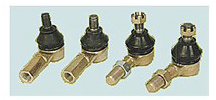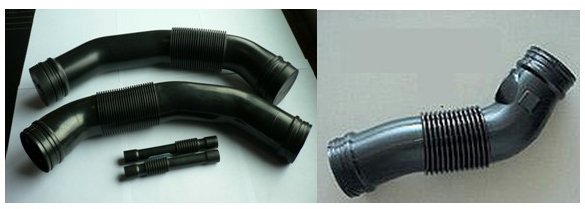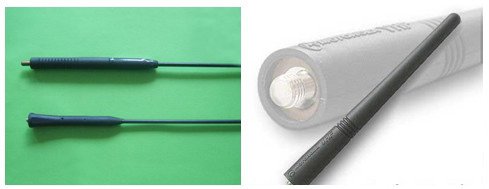SUNPRENE @ TPEE (Thermoplastic Polyester Elastomer) is a block copolymer containing polyester hard segments and polyether soft segments. Wherein the polyether soft segment and the non-crystalline polyester form the amorphous phase, the hard segment of the polyester partially crystallizes to form a crystalline micro-zone, which serves as a physical crosslinking point. SUNPRENE @ TPEE has the elasticity of rubber and the strength of engineering plastics; the soft satin gives it the elasticity to make it resemble rubber; the hard segment gives it the processing ability to make it like plastic; it has better processability and longer Life; compared with the engineering materials, the same high strength characteristics, and flexibility and dynamic mechanical properties better.
1. Mechanical properties, by adjusting the ratio of soft and hard segments, SUNPRENE @ TPEE hardness from Shore 26-75D, the flexibility and strength between the rubber and plastic. Compared to other thermoplastic elastomers, the TPEE modulus is higher than other thermoplastic elastomers of the same hardness at low strain conditions. When modulus is an important design condition, TPEE reduces the cross-sectional area of the product and reduces the amount of material used. TPEE has a very high tensile strength. Compared with polyurethane (TPU), TPEE material has much higher compressive modulus and tensile modulus. With the same hardness of TPEE and TPU making the same part, the former can withstand greater load. Above room temperature, TPEE flexural modulus is high, but not as low as TPU so hard and therefore suitable for the production of cantilever or torque-type components, especially for the production of high-temperature components. Low temperature flexibility of TPEE material Good cold notch impact strength is better than other TPE, abrasion resistance and TPU quite. Under low strain conditions, TPEE has excellent fatigue resistance and less resistance to shield loss, a feature that is combined with high resilience to make this material an ideal material for many cyclic loads, with gear cams, flexible couplings Shaft joints, belts can be used.
2. SUNPRENE @ TPEE has the advantages of excellent heat resistance, higher hardness and better heat resistance. SUNPRENE @ TPEE raw material is heated at 110-140 ℃ for 10h and is basically free from weight loss. Heating at 160 ℃ and 180 ℃ for 10h respectively, Only 0.05% and 0.1%. Therefore TPEE material has very high service temperature and short-term service temperature, can adapt to the temperature of baking paint (150-180 ℃) in automobile production line, and it has little loss of mechanical performance under high and low temperature. TPEE at 120 ℃ above the use of its tensile strength is much higher than the TPU In addition TPEE also has excellent low temperature resistance, TPEE brittle point below -70 ℃ and the lower the hardness, the better the cold, most of the TPEE - 40 ℃ long-term use. Due to its balanced performance at high and low temperatures, TPEE has a very wide operating temperature range of -70 to 180 ° C.
3. Chemical-resistant SUNPRENE @ TPEE materials have excellent oil resistance and are resistant to most polar liquid chemical media (such as acids, alkalis, and amine diols) at room temperature but not to halogenated hydrocarbons (except Freons) and The phenolic effect is poor, and its chemical resistance increases with its hardness. TPEE for most organic solvents, fuels and gases anti-swelling performance and anti-permeability is good, the permeability of the fuel only neoprene, chlorosulfonated polyethylene, nitrile rubber and other oil-resistant rubber 1/3 to 1 / 300 But TPEE poor hot water resistance, adding a polycarbodiimide stabilizer can significantly improve its hydrolysis resistance.
4. Weatherability and aging resistance, SUNPRENE @ TPEE materials in many different conditions, such as water mist, ozone, outdoor atmospheric aging conditions, excellent chemical stability. Like most elastomers, degradation occurs under UV light so that UV protection aids, including carbon black and various pigments or other shielding materials, should be added to the material for sunlight applications in outdoor applications or articles In addition, TPEE also has different degrees of hydrolysis.
SUNPRENE @ TPEE Raw Material Application: TPEE is mainly used in the fields that require shock absorption, impact resistance, scratch resistance, tightness and elasticity, oil resistance, chemical resistance and sufficient strength. Such as: polymer modification, automotive components, high and low temperature wire jackets, hydraulic hoses, shoe materials, drive belts, rotational molding tires, flexible coupling, silencer gear, elevator slides, chemical equipment in the pipeline valve Anti-corrosion wear-resistant high temperature materials.
Thermoplastic elastomer SUNPRENE @ TPEE introduction and the specific application areas
SUNPRENE @ TPEE is made by copolymerizing 1,4-butanediol terephthalate and polybutanol. The increase of hard segment ratio can enhance the physical rigidity and chemical stability. Increasing the proportion of soft segment increases the flexibility and low temperature performance. TPEE (SUNPRENE is a registered trademark of Sichuan Chenguang New Plastics Co., Ltd. It is an ester system of thermoplastic elastomer Thermoplastic elastomers, its flexibility and resilience resembles rubber, and mechanical strength, heat resistance and weatherability Rubber than the excellent. Without vulcanization project, the same with the ordinary thermoplastic resin, easy to shape the resin according to the usual polyester synthesis method to properly adjust the amount of the soft segment copolymer to form suitable for a variety of uses of soft and mechanical materials .
Has the characteristics:
⒈ good creep resistance, impact resistance and fatigue resistance.
⒉ high impact strength and good low temperature flexibility.
3.Maintain good performance when temperature rises.
⒋ Good resistance to chemicals, oils, solvents and weather.
⒌ high tear strength and high abrasion resistance.
⒍ easy to process and economical.
⒎ Good recyclability.
Common model specifications: 26D-75D
26 ~ 30D has similar flexibility, elasticity and mechanical strength as rubber, but its heat resistance and weatherability are better than rubber. All grades of SUNPRENE @ TPEE are block copolymers consisting of a hard (crystalline) segment of polybutylene terephthalate and a soft (amorphous) segment based on long chain polyether ethylene glycol. Its properties are determined by the ratio of hard to soft segments.
Applications: Hose sleeves, hydraulic hoses, pipes, sealing materials
40D has similar flexibility, elasticity and mechanical strength as rubber, but its heat resistance and weather resistance are better than those of rubber.
Applications: Sporting goods such as films and components, including the golf ball's epidermis
55D has similar flexibility, elasticity and mechanical strength as rubber, but its heat resistance and weatherability are better than rubber.
Applications: Molding materials, automotive components, belts, hard and soft pipe.
63D has rubber-like flexibility, elasticity and mechanical strength, but its heat resistance and weatherability are better than rubber.
Applications: fuel tank part, sealant, various gears, keypad, telephone antenna, Phos type, compression spring, pipe coating, Inline-skate roller
72D has similar flexibility, elasticity and mechanical strength as rubber, but its heat resistance and weatherability are better than rubber.
Applications: gears, bearings, telephone line envelope.
SUNPRENE @ TPEE in Electrical and Electronic Applications
First, the cable system TPEE in wire and cable in an increasingly wide range of applications, commonly used for wire (cable) sheath, fiber sheath, connectors and so on. These uses mainly TPEE the following properties: sealing, thermal properties, flexibility, abrasion resistance, scratch resistance, corrosion resistance, creep resistance, anti-aging, environmental stability, long service life and so on. Flame retardant requirements, TPEE can meet.
The following are typical uses:
1, spiral phone line jacket recommended grade: H8570Y or flame retardant grade FH8570 Advantages: heat resistance, creep resistance, low temperature flexibility Copper stable enough temperature stability, non-stick insulation. The low creep properties required to maintain the helix, the excellent mechanical properties after heat aging (tensile strength, elongation at break, etc.), low temperature flexibility and copper stability simplify the manufacturing process.
2, fiber jacket Recommended grades: H8570Y, H9275Y or flame retardant grade Advantages: to withstand the harsh underground environment to protect the fiber from lead and radiation erosion, excellent impact resistance and flex resistance to meet the requirements of anti-UV, easy to stain , High yield.
3, fiber system recommended grade: H2040 or flame retardant grade FH2040 Advantages: high flexibility and tear strength, chemical resistance, flame retardant, easy to dye, long-term sealing of dust and liquid role. Figure has excellent tear strength, so that fiber can rotate a certain angle without rupture. We provide all kinds of flame retardant grade TPEE products, processing performance, high yield.
Second, the electronics industry
Recommended mobile phone antenna jacket: H2040, H6055 Advantages: for the phone antenna jacket. TPEE dielectric constant, conductivity and dielectric loss factor are in line with international standards. Antenna made with TPEE has a small effect on the brain, it emits the cell phone radio waves on the brain to launch the least energy, the user is the safest guarantee.
Recommended parts of electrical components: H7560Y, H8570Y Advantages: the best bending fatigue properties, excellent creep resistance Performance: TPEE bending fatigue in all commercial plastic materials the best performance, TPEE also has a very excellent creep resistance , Together with other unique properties of TPEE ensure long-term service life and stability. Some products using V-0 flame retardant grade TPEE production.
Train sleeper pad special thermoplastic polyester elastomer (SUNPRENE @ TPEE H2040T)
TPEE has high structural strength, good creep resistance, excellent resilience, impact and bending fatigue resistance, wear resistance, dimensional stability. Flexibility at low temperatures and good performance at high temperatures. In particular, excellent dynamic mechanical properties make it stand out in a wide range of elastomeric materials. In addition, it can resist the corrosion caused by many industrial chemicals, oils and solvents. Compared with rubber, TPEE material has a longer service life and is more resistant to compression deformation. Performance is consistent over the temperature range of -55 degrees to 150 degrees.
Technical testing: By the external force of materials, components or structures to resist deformation, that is, the amount of force and the resulting deformation. The formula is written as: K = P / &. Where K represents the stiffness, P said force, & that the amount of deformation (the length after deformation minus the original length or original length minus the length after deformation). In international units, stiffness units are in N / m. Generally applied to the Hook's law as a system of vibration analysis.

|
| Train pillow cushion |
The stiffness of the material is measured by the amount of external force required to deform it. The stiffness of an isotropic material depends on its elastic modulus E and shear modulus G (see Hooke's law). In addition to the rigidity of the structure depends on the elastic modulus of the material, but also with its geometry, boundary conditions and other factors and the role of external forces form.
According to the product stiffness detection method, the stiffness is divided into two kinds of static stiffness and dynamic stiffness. The ability to resist deformation under static load is called static stiffness and is generally measured by how much the structure is deformed under static load. The ability to resist deformation under dynamic load is called dynamic stiffness, which is the dynamic force required to cause unit amplitude, which is generally measured by the natural frequency of the structure. Therefore, dynamic stiffness is a measure of the ability of a structure to resist a predetermined dynamic disturbance. In particular, the dynamic stiffness of viscoelastic damping elements, such as rubber, is a key indicator of damping performance.
At present, sleeper rubber pads due to long-term exposure to the atmosphere, requiring a good resistance to natural aging and cold, heat resistance. Over the years, Chenguang TPEE railway sleepers produced by the strict implementation of the Ministry of Railways TB / T2626 standards. Has passed the testing standards, as follows:
(1) Dynamic Stiffness: TB / T2626
(2) Static stiffness: TB / T2626
(3) Talib wear: GB / T5478
(4) Oil volume expansion rate: GB / T1690
Use: TPEE railroad pillow pad, located between railroad tracks and railway sleepers, to withstand the impact of each passing wheel on the sleeper and sleepers impact load and crush load, effectively reducing and cushioning the train when the high-speed rail through Produces noise, heat, shock and vibration, protecting subgrade and sleeper.
TPEE production of railway sleeper cushion if micro-foaming process better. The useful life of the pillowcases is roughly equivalent to four rubber pads, three EVA pads or two TPU pads, resulting in long-term cost savings. Currently Sichuan Chenu Ke new plastic limited liability company SUNPRENE @ TPEE produced by the railway sleeper cushion in the domestic subway, high-speed rail put into use.
The application of SUNPRENE @ TPEE in the automotive field is getting more and more attention and development. TPEE has excellent resistance to (hot) oil, excellent (high temperature and low temperature) flex fatigue performance, wear resistance, high strength and toughness. All kinds of elastomer parts made of TPEE have better overall performance than rubber parts, and have higher temperature resistance and better low-temperature characteristics. In particular, the fatigue performance of TPEE is unmatched by other elastomers. Mainly used in the automotive parts: CVJ dust cover, ball dust cover, cantilever sheath, rod sheath and other dust cover and jacket; ball wrist; air hose (engine intake air duct) Airbag, Seat Belt Parts, Automotive Headlamp, Car Door Lock, Satellite Antenna Clamp, Door Handle Seal Ring, Anti-Shock Abatement Board, Noise Reduction Gear, Pipe Plug, Jamming, Window Glass Shock Absorber Earthquake chassis, chassis and other anti-stone coating.
The following are typical uses:
1, CVJ dust cover recommended grades: H3303B, H5046B, H5550B, H605B
Role: The CVJ Dust Cover is a car steering ball cage that holds oil and prevents dust, water and salt from entering the lubrication system. Performance requirements: excellent (high temperature) fatigue performance, long-term erosion of hot oil.
Advantages: TPEE excellent low temperature fatigue resistance, up to 100 ℃ long-term oil erosion. TPEE offers more advantages than CR rubber (neoprene). Such as: recyclable; Compared with the traditional rubber (neoprene), can reduce the weight of half, double the service life. TPEE better quality and longer service life (more 10-30 million Km), low deformation retention, better high and low temperature performance and wear resistance, defective rate is very low. Excellent processability, forming a stable parison in a blow mold. Ball dust cover, cantilever sheath, steering sheath and other dust cover and jacket can be used as a material TPEE, with the same advantages

2, ball wrist recommended grade: H7560Y
Performance requirements: resistance to dynamic fatigue, wear resistance, high strength, high toughness.
Advantages: Excellent dynamic fatigue performance, wear resistance, high strength, high toughness, the balance of various physical properties

3, air hose recommended grade: H605B
Effect: (between air cleaner and turbocharger) Increases intake pressure and raises gas temperature. Performance requirements: to withstand a certain pressure, excellent high temperature strength, high temperature creep deformation.
Advantages: TPEE excellent thermal properties (high temperature strength, high temperature creep resistance), better processing performance (blow molding, thermal welding, etc.), processing methods: usually using negative pressure blow molding.

4, airbag recommended grade: H605
Requirements: high toughness under low temperature, high tear strength, easy to paint.
Advantages: low temperature, high toughness, high tear strength, easy to paint. TPEE without primer, long-term paint adhesion is excellent. Its flexibility ensures that the airbag has good gloss when unrolled at low temperatures. Its tear strength is high, the product can be thinned wall thickness. TPEE has been widely used in the airbag housing due to its balanced performance at high and low temperatures. The shell can be sprayed; does not affect the performance of the shell after spraying; good spray adhesion; volatile components contained will not be atomized; UV resistance; impact resistance.

5, car headlight seat recommended grade: H7560Y
Advantages: High strength, excellent weatherability, good creep resistance at high temperatures, excellent combination of rigidity and toughness.
Use performance: excellent anti-fatigue performance, weathering performance is good. For headlight holders, with a good wear resistance equivalent to 30% glass-reinforced PA66. Easy to dye and process.
6, recommended car satellite antenna clamp H6055
Advantages: The perfect combination of toughness and strength, flexibility to ensure that products at low temperatures gloss, strength and weatherability to ensure adequate service life, extrusion molding.
